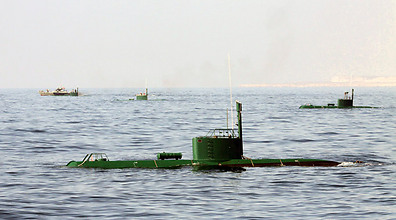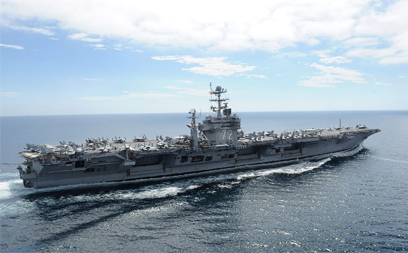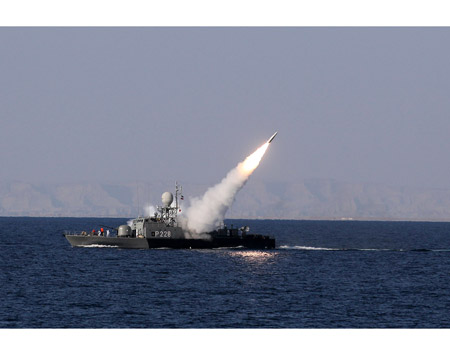Washington Post reports American security experts believe that Iran’s upgraded military capabilities are factor in case of military confrontation in Persian Gulf
Ynet
Experts estimate that Iran is bolstering its retaliation capabilities against US naval ships in the Persian Gulf– among other things Tehran is amassing an arsenal of advanced anti-ship missiles and expanding its fast attack boat fleet, the Washington Post reported on Friday.

Iranian naval drill in Persian Gulf – Photo: AP
According to the Post, officials claimed that the new systems, many of which were developed with foreign assistance, are giving Iran’s commanders new confidence that they could quickly damage or destroy US ships if hostilities erupt.
Although US Navy officials are convinced that they would prevail in a fight, Iran’s advances have fueled concerns about US vulnerabilities during the opening hours of a conflict in the gulf.
Experts including current and former military analysts believe that increasingly accurate short-range missiles— combined with Iran’s use of “swarm” tactics involving hundreds of heavily armed patrol boats — could strain the defensive capabilities of even the most modern US ships.
According to expert assessments, the likelihood that Iran would risk an all-out attack on a vastly superior US fleet is small. But leaders in the Islamic Republic could decide to launch a limited strike if Israel or the United States bombed the country’s nuclear facilities.
‘Devastating first salvo’
Iran’s ability to inflict significant damage in this scenario is substantially greater than it was a decade ago. A Pentagonstudy in April warned that Iran had made gains in the “lethality and effectiveness” of its arsenal.
Iran’s increased power to retaliate has led some military experts to question the wisdom of deploying aircraft carriers and other expensive warships to the gulf if a conflict appears imminent.

Iran has growing naval capabilities – Photo: EPA
A 2009 study prepared for the Naval War College warns of Iran’s increasing ability to “execute a massive naval ambush” in the Strait of Hormuz, a narrow waterway dotted with small islands and inlets and perfectly suited for the kind of asymmetric warfare preferred by Iran’s commanders.
According to the study: “If the US chooses to station warships in the Strait of Hormuz during the buildup to conflict, it cedes the decision of when to fight and allows the fight to begin in the most advantageous place for Iran.
“This could lead to a devastating first salvo on US Navy warships, which would most likely be operating under restrictive rules of engagement.”
Since the study’s release in 2009, analysts say, Iran has added defensive and offensive capabilities.
Some of them have been on display in recent months in a succession of military drills, including a missile exercise in early July dubbed Great Prophet 7.
The exercise included a demonstration of Iran’s newly deployed Khalid Farzh anti-ship missile, which has an internal guidance system, a powerful 1,400-pound warhead and a range of 180 miles.

New anti-ship missiles? – Photo: Reuters
The April Pentagon assessment signed by US Defense Secretary Leon Panetta noted that Iran’s arsenal now includes ballistic missiles with “seekers” that enable them to maneuver toward ships during flight.
Modern US warships are equipped with multiple defense systems, such as the ship-based Aegis missile shield. But Iran has sought to neutralize the US technological advantage by honing an ability to strike from multiple directions at once.
The emerging strategy relies not only on mobile missile launchers but also on new mini-submarines, helicopters and hundreds of heavily armed small boats known as fast-attack craft.
‘360-degree threat’
A Middle Eastern intelligence official who helps coordinate strategy for the gulf with US counterparts said some Navy ships could find themselves in a “360-degree threat environment,” simultaneously in the cross hairs of adversaries on land, in the air, at sea and even underwater.
“This is the scenario that is giving people nightmares,” said the official, who spoke on the condition of anonymity in discussing strategy for defending against a possible Iranian attack.
In line with these assessments the Navy has ordered new systems for defending against small-boat “swarms,” including ship-launched unmanned aerial vehicles and special missiles and artillery rounds for use against fast-attack craft.
But many of the new defenses will not be deployed for several months, said Michael Eisenstadt, a former military adviser to the Pentagon and the State Department.
“We’re behind and we’re catching up,” Eisenstadt added. “But if there’s a conflict in the near term, we may not be completely ready.”
Experts believe US forces would probably recover quickly from any early losses, but Iranian leaders could claim a psychological victory if the world’s media carried images of burning US warships in the gulf.
“A lot of Iranian ships would be at the bottom of the gulf, but Iran would be able to point to a victory,” Eisenstadt said.
“The outcome would never be in doubt when you’re dealing with the most powerful military in the world. But in their minds they would have shown the world that if you mess with us, you’ll pay a heavy price.”
Meanwhile, US ships continue steaming toward the gulf as the Obama administration seeks to reassure allies in the region and discourage Iran from moving to block the flow of oil through the Strait of Hormuz.
US and Middle Eastern officials acknowledge that deployments carry inherent risk, but they say there are no good alternatives.
“It is a dilemma,” the Middle East intelligence official said. “When the Navy ships are in the strait, they are vulnerable to attack. But if you were to take them away, the gulf countries would feel more vulnerable. And already they feel very, very vulnerable.”
View original Ynet publication at: http://www.ynetnews.com/articles/0,7340,L-4261181,00.html






 Israeli New Shekel Exchange Rate
Israeli New Shekel Exchange Rate